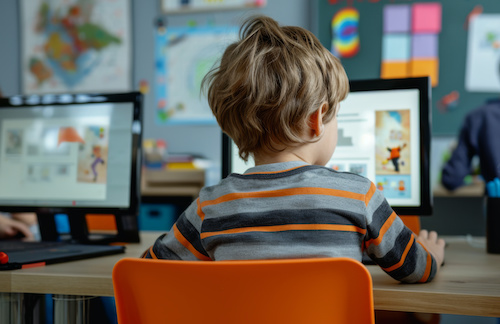
As a bilingual kindergarten teacher, one of my goals for this new school year is to strengthen the home-school connection by encouraging families to use technology with intention and care. Children today are growing up in a world where digital tools are everywhere. But how we guide and support their use of technology can make all the difference in their learning journey.
Why This Matters
Technology is not just about screens or devices. When used thoughtfully, it becomes a bridge to learning, creativity, and discovery. In our classroom, we use digital tools to help students engage, explore, and build independence. However, families are a crucial part of this process especially when it comes to using technology at home.
This year, I created a flyer for my kindergarten families titled “Technology and Learning in Kindergarten: Building the Future Together from Home!” to promote awareness and collaboration. Below, I share an adapted version in Spanish as part of my commitment to culturally responsive teaching and digital inclusion.
A Message for Families Make the Most of Tablet Time
If your child uses a tablet or smartphone at home:
- Choose educational content such as songs, interactive stories, or apps for counting and letters
- Watch videos together even a few minutes can lead to valuable conversations
- Set clear limits and balance screen time with hands-on activities like drawing, retelling stories, or playing with letters
Learning Can Be a Game
Gamification turning lessons into games helps children stay motivated and focused (Kapp, 2012). Apps that reward kids for solving problems or completing tasks turn learning into an adventure.
Mix Digital Tools with Creative Play
Videos and apps that encourage movement, singing, or building are wonderful for reinforcing learning. The key is variety and keeping curiosity alive. Blended learning mixing digital and real-world activities enhances both cognitive and physical development (Neumann & Neumann, 2014).
Family Involvement Matters
Educational success is stronger when families are engaged. Research shows that children perform better when their caregivers participate in digital learning at home (ABC Life Literacy Canada, 2024). It’s not just about limiting screen time, but being part of it.
Preparing for the Future Starts Today
Technology will continue to shape future careers, and early exposure builds foundational skills like critical thinking, creativity, and problem-solving (Robinson, 2010). But those skills thrive best when supported by caring adults who nurture growth and curiosity.
Final Reflection
“Technology doesn’t replace great teachers or attentive families. But when used with intention, it can open the doors to a wonderful world of learning.”
As we begin this school year, I invite all families to partner with me in building a learning environment both at school and at home where technology is used with purpose, balance, and joy.
Together, we can guide our children toward a future full of opportunities, imagination, and discovery.
References (APA 7th edition)
ABC Life Literacy Canada. (2024, May 13). Empowering learning: Leveraging technology in adult education. https://abclifeliteracy.ca/news/empowering-learning-leveraging-technology-in-adult-education/
Kapp, K. M. (2012). The gamification of learning and instruction: Game-based methods and strategies for training and education. Pfeiffer.
Neumann, M. M., & Neumann, D. L. (2014). Touch screen tablets and emergent literacy. Early Childhood Education Journal, 42(4), 231–239. neuman__touch_screen_tablets_and_emerg_lit.pdf
Robinson, K. (2010). Bring on the learning revolution! [Video]. TED. https://www.ted.com/talks/sir_ken_robinson_bring_on_the_learning_revolution
Download the Spanish flyer shared with families: